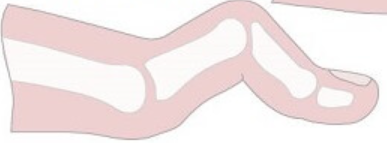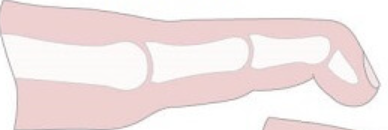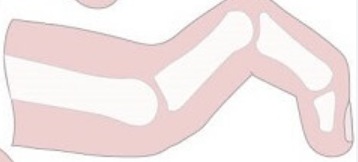Ankle and Foot
1/41
There's no tags or description
Looks like no tags are added yet.
Name | Mastery | Learn | Test | Matching | Spaced |
|---|
No study sessions yet.
42 Terms
complaint, mechanism, weight bear, description, claudication, neurologic, occupation, recreational, skin temperature, vascular
history should include chief _____, _____ of injury, ability to _____ following injury, pain _____ (cramping/aching may accompany _____, numbness/tingling may indicate _____), _____ and _____ activities, change in _____ (potential _____)
swelling, discoloration, nail, condition, callus, posture, height, alignment, deformities, weight bearing, footwear, wear
observation should include _____, skin _____, _____ and skin _____, _____ formation, foot _____ and arch _____, toe _____ or _____, _____ status, _____ with _____ pattern
hammer toe
PIP flexion, MTP and DIP hyperextension

mallet toe
DIP flexion

claw toe
PIP and DIP flexion, MTP hyperextension

hallux valgus
proximal phalanx deviates laterally, first metatarsal drifts medially, increased prominence of first metatarsal head
laterally, progressive, deformities, overlapping
hallux valgus will cause WB to shift _____, may contribute to _____ gait deviations and further toe _____ (_____ toes)
morton’s toe
longer second toe
metatarsus adductus
metatarsal bones deviated inward
dynamic, double, single, squats, gait, jumping, landing, running
movement analysis allows _____ assessment, may include _____/_____ leg _____, strength/ROM, _____ examination, _____ and _____ mechanics, and _____
lateral ankle sprain
most common foot/ankle injury, most common sports injury
inversion, plantarflexion, anterior tibiofibular ligament, plantarflexion, inversion, calcaneofibular ligament, dorsiflexion, inversion, posterior tibiofibular ligament
lateral ankle sprain MOI is _____ usually with _____, sequence of injury is _____ (_____ and _____) then _____ (_____ and _____), and _____
bruising, proprioceptive, ROM, impingement, chronic ankle instability, fracture, osteochondral, altered, cartilage, osteoarthritis
lateral ankle sprain secondary complications include bone _____, _____/_____ deficits, ankle _____, _____ (CAI), _____, _____ defect, _____ kinematics causing _____ stress causing _____
lateral ankle sprain, women, dorsiflexion, hip abductor, extensor, asymmetry, functional, court, prophylactic bracing
lateral ankle sprain risk factors include history of _____, more _____, limited _____, decreased _____/_____ strength, _____ or poor performance on _____ outcome measures, participating in _____ sports without _____
grading, extent, number, presentation, functional
no universal _____ system on ankle sprain severity, may be based on _____ of damage to single ligament, _____ of ligaments injured, _____ and _____ impairments
stretched, ATFL, mild, tenderness, limited, no, full, normal, little
West Point ankle sprain grading system grade I is _____ ligament (_____), _____ point _____, _____ dysfunction, _____ laxity, _____ WB, _____ gait, _____ edema
partially torn, ATFL/CFL, diffuse, tenderness, moderate, slight, painful, antalgic, moderate local
West Point ankle sprain grading system grade II is _____ ligament (_____), _____ and point _____, _____ dysfunction, _____ laxity, _____ WB, _____ gait, _____ edema
substantially torn, ATFL/CFL/PTFL, diffuse, tenderness, significant, definite, severe pain, AD, significant diffuse
West Point ankle sprain grading system grade III is _____ ligament (_____), _____ and point _____, _____ dysfunction, _____ laxity, _____ WB, needs _____, _____ edema
trauma, malleolar zone pain, posterior lateral malleolus tenderness, posterior medial malleolus tenderness, inability to weight bear immediately and in ED
ottawa ankle rule radiograph ordered after _____ with _____ and _____/_____/_____
trauma, midfoot zone pain, metatarsal base tenderness, navicular bone tenderness, inability to weight bear immediately and in ED
ottawa foot rule radiograph ordered after _____ with _____ and _____/_____/_____
figure 8 edema measurement, anterior drawer, medial talar tilt, weight bearing lunge
lateral ankle sprain special tests (4)
sensorimotor, ROM, strength, fibularis, reaction time, dorsiflexion, plantarflexion, mobility
lateral ankle sprain presents with _____ and _____ deficits including decreased leg/ankle _____, decreased _____ muscle _____, decreased _____/_____, increased forefoot and midfoot _____
movement, ankle, knee, hip, both, balance, gait, jumping
lateral ankle sprain presents with altered _____ strategies, in _____/_____/_____, in _____ extremities, occur during _____/_____/_____
pain, edema, POLICE, external support, gait, sagittal, AROM, pain free, isometrics, low, joint mobilizations, estim
lateral ankle sprain acute phase protection interventions should control _____ and _____, use _____, _____ as needed, _____ training, gentle _____ plane _____ in _____ range, gentle _____, _____ grade _____, _____ as needed
brace, gait, mobilizations, resistance, intensity
lateral ankle sprain subacute phase controlled motion interventions include _____ to provide stability, _____ training, joint _____, progress therex _____ and _____
strengthening, neuro reed, external support, functional
lateral ankle sprain chronic phase return to function interventions should progress _____ and _____, no _____ during training, use _____ movement patterns
run, surface, plyometrics, sport specific, prophylactic bracing
lateral ankle sprain return to sport interventions include _____ progression considering _____, _____, _____ training, use _____ and appropriate footwear
chronic ankle instability
long term complication of lateral ankle sprain
one year, giving way, pain, weakness, ROM, self reported function, ankle sprains
CAI symptoms persist for more than _____ after initial injury, repetitive episodes of ankle _____, ongoing _____/_____/reduced _____, diminished _____, recurrent _____
single leg drop landing, double leg drop landing to vertical jump, dynamic control, SEBT, ADL
predictors of CAI is 2 weeks is inability to complete _____ and _____, 6 months poor _____ of hip/knee/ankle with _____ in posteromedial and posterolateral directions and lower scores on _____ subscale of FAAM
primary tissue injury pathomechanical, sensory perceptual, motor behavioral, personal, environmental, outcome, CAI, coper
components of CAI include _____ (ankle sprain), _____ impairments, _____ impairments, _____ impairments, _____ and _____ factors, leading to continuum of _____ from _____ to _____
both, muscle activation, strength, force, proprioception, dorsiflexion, motion, spinal, reflex, supraspinal corticomotor, movement
CAI sensorimotor findings in _____ limbs include abnormal timing of _____, decreased _____, impaired _____ and _____, decreased ankle _____, increased subtalar/midfoot _____, impaired _____ level control and _____ inhibition, abnormalities of _____, affects _____ system
strength, dynamic balance, postural stability, joint mobilizations, dry needling, fibularis
CAI interventions include neuro reed and therex to improve _____/_____/_____, manual therapy including _____, and _____ to _____ muscle group
5, 24, 11
CAI patient report outcome cut offs include ankle instability instrument yes to at least _____ questions, cumberland ankle instability tool score equal to of less than _____, identification of functional ankle instability score of equal to or greater than _____
hop, lift, balance, sls, posteromedial, SEBT, barefoot, correlate
CAI functional outcome measures include _____ tests, foot _____/time in _____/_____ of BESS, _____ of _____, all tests performed _____, _____ with other symptoms
high ankle sprain/syndesmotic injury
injury to distal tibiofibular joint or syndesmosis
interosseous membrane, anterior inferior tibiofibular ligament, fracture, widening
high ankle sprain injury may include _____ and _____, may have concurrent _____, excessive _____ between tibia and fibula during dorsiflexion
external rotation, dorsiflexion
high ankle sprain MOI is excessive _____ with possible _____
anterolateral pain, AITFL, weight bear, swelling, bruising
high ankle sprain presents with _____ proximal to _____, difficulty/inability to _____, less _____ and _____ than lateral ankle sprain
dorsiflexion external rotation, syndesmosis squeeze
high ankle sprain special tests (2)
NWB, pain free, brace, external rotation, lateral ankle sprain, delayed
high ankle sprain interventions include _____ in cast for 2-3 weeks, delayed WB until _____, use _____ that limits _____, similar treatment to _____ but _____
deltoid ligament, rare, fracture, excessive eversion, lateral talar tilt
medial ankle sprain is sprain of _____, very _____, usually with ankle _____, MOI is _____, special test is _____